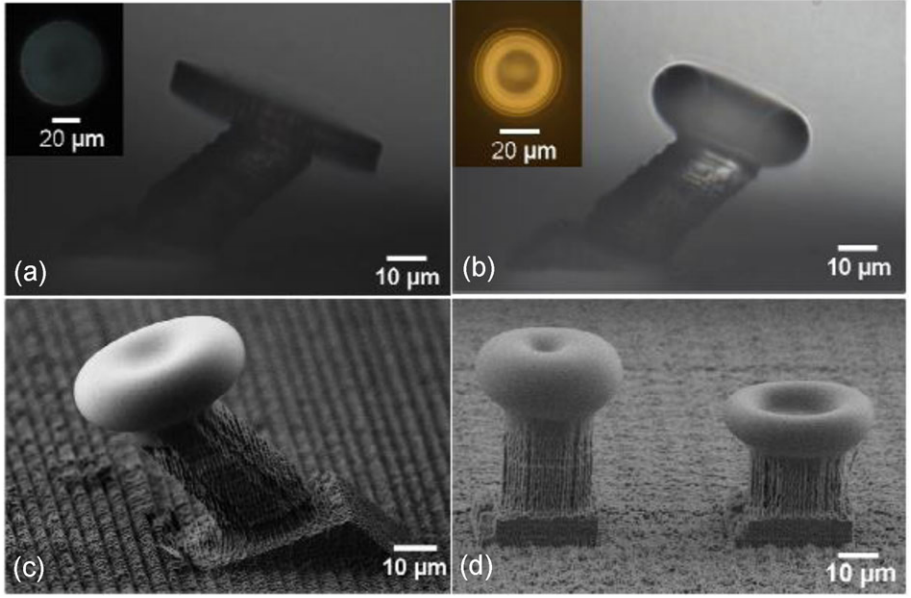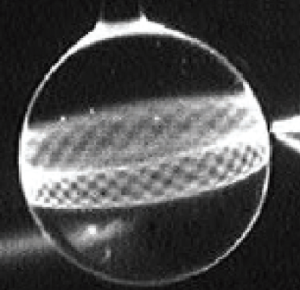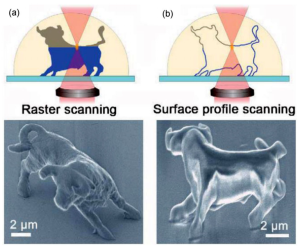Whispering-gallery modes are the phenomena of waves traveling along the curve of a concave surface without degrading. The concept was first explained by Lord Rayleigh in 1878 as he explained the effect that produced traveling whispers in St. Paul’s Cathedral. Because the sound waves cling to the curved walls, they don’t decay as they would against square walls, but actually continue for a much greater distance, making even whispering sounds audible all around the gallery. And it isn’t just sound waves that follow this unique dispersal pattern, the process has also been observed for radio waves, microwaves, ultraviolet waves and light waves.
Huailiang Xu and Hongbo Sun from Jilin University State Key Laboratory on Integrated Optoelectronics recently published a paper called “Femtosecond laser 3D fabrication of whispering-gallery-mode microcavities“. The paper demonstrates a method of utilizing femtosecond (extremely fast and small) laser 3D printing to create whispering-gallery-mode microcavities that will confine light inside of them. The process will be useful for a wide variety of micro-scale technologies like micro-lasers, micro-sensors and micro-filters. The process could be one of the basic building blocks of integrated photonic systems which could lead to the development of advanced micro-scale data processing technologies.
Femtosecond laser direct writing (3D printing) has been a hotly researched technology in recent years. A femtosecond laser pulses so rapidly than the pulses are measured at the rate of one quadrillionth, or one millionth of one billionth, of a second. The pulsing speeds make these lasers capable of creating extremely small features in photosensitive materials, similar to stereolithography only much smaller with a significant increase in detail. The process is being researched for several varieties of technologies, ranging from micro-fluidics, optoelectronics, micro-electronics, micro-machines, micro-sensing, to micro-biomimetics and micro-optics. However using the process to fabricate high quality whispering-gallery-mode microcavities to trap light waves is a new area of research that could lead directly to breakthroughs in advanced quantum data storage and processing.
Xu and Sun’s review article offers a brief introduction on the basic principles of femtosecond laser processing. Then they move on to the use of high-quality micro-fabrication using the femtosecond laser processing technique to generate micro-scale 3D structures in the photosensitive polymer material. They also discuss their success in fabricating 3D passive and active whispering-gallery-mode microcavities using several varieties of polymers as well as glass and crystal structures. They also introduced the process of fabricating an integrated micro-sensor device with a whispering-gallery-mode microcavity.

Optical microscope images of fused silica microdisks fabricated by femtosecond laser processing and chemical wet etching
“It is believed the further effort on the investigation of femtosecond laser 3D fabrication of high-Q factor microcavities will undoubtedly benefit the applications of microcavities in a broad spectrum from bio-sensing and optoelectronics to quantum information,” explained the pair of researchers in their paper.
While the research being conducted here is exciting news for the possible development of high-peed and high-volume data processing and storage devices, it is still too early to determine how practical the process will be. Not only is the process still quite challenging, but Xu and Sun still need to demonstrate that fabricating these high quality microcavities using femtosecond laser direct writing will have usable applications. The review paper has been published in SCIENCE CHINA Physics, Mechanics & Astronomy, volume 58, Issue 11.
Subscribe to Our Email Newsletter
Stay up-to-date on all the latest news from the 3D printing industry and receive information and offers from third party vendors.
You May Also Like
Precision at the Microscale: UK Researchers Advance Medical Devices with BMF’s 3D Printing Tech
University of Nottingham researchers are using Boston Micro Fabrication‘s (BMF) 3D printing technology to develop medical devices that improve compatibility with human tissue. Funded by a UK grant, this project...
3D Printing Webinar and Event Roundup: April 21, 2024
It’s another busy week of webinars and events, starting with Hannover Messe in Germany and continuing with Metalcasting Congress, Chinaplas, TechBlick’s Innovation Festival, and more. Stratasys continues its advanced training...
3D Printing Webinar and Event Roundup: March 17, 2024
It’s another busy week of webinars and events, including SALMED 2024 and AM Forum in Berlin. Stratasys continues its in-person training and is offering two webinars, ASTM is holding a...
3D Printed Micro Antenna is 15% Smaller and 6X Lighter
Horizon Microtechnologies has achieved success in creating a high-frequency D-Band horn antenna through micro 3D printing. However, this achievement did not rely solely on 3D printing; it involved a combination...
































